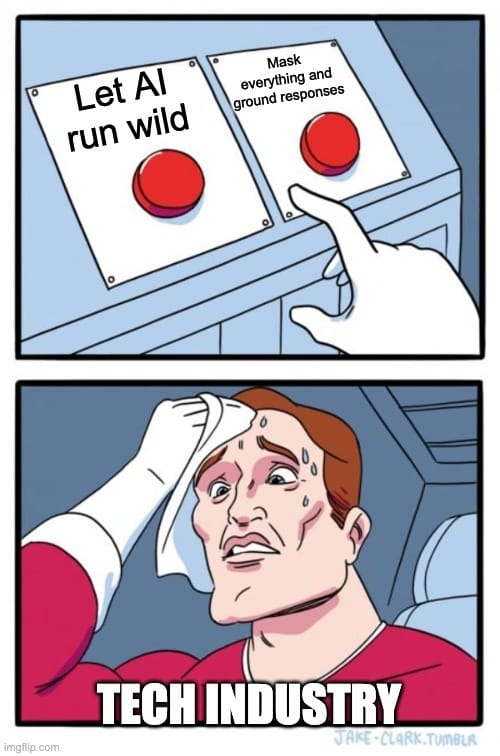- SalesforceChaCha
- Posts
- 💃 AI with a Seatbelt 🕺
💃 AI with a Seatbelt 🕺
How Salesforce keeps generative AI from going off the rails
Good morning, Salesforce Nerds! In case you were wondering, Salesforce didn’t just bolt generative AI onto its platform and call it a day.
They baked in something smarter. The Einstein Trust Layer. 🔐
A behind-the-scenes security net designed to keep your customer data safe while letting AI work its magic.
It’s like putting a seatbelt on AI.
It can still drive fast and make bold decisions, but with a layer of control that keeps everything compliant, secure, and trustworthy. 💥
That’s critical in an enterprise platform like Salesforce, where leaking PII or hallucinating nonsense isn’t just bad. It’s brand-destroying.
And unlike some vendors that treat AI like a black box, Salesforce cracked it open and wrapped it in enterprise-grade guardrails. 🛡️

TABLE OF CONTENTS
💃 AI with a Seatbelt 🕺
ONE SHIELD ISN’T ENOUGH
WHY TRUST NEEDS LAYERS
Salesforce’s AI platform isn’t just one model doing it all. 🚫
It’s a system of connected parts: your data, Salesforce metadata, third-party LLMs (like OpenAI), and real-time user prompts.
The Trust Layer weaves through them like Kevlar. Tightening privacy controls at every junction. 🔧
Here’s where trust can break down without a layer like this:
Sensitive customer data accidentally sent to a public LLM? 🚨
No audit trail of what the AI generated or why? 🕳️
Prompt injections from crafty users? 🤖💀
The Trust Layer plugs these holes and acts like a middleware bouncer.
It sits between the Salesforce platform and the AI model, controlling every token that goes in or out.
Filtering what’s shared, masking what’s private, and logging everything. 🔥
This is not just marketing fluff.
It’s a real architectural layer with concrete responsibilities. 🤝

BEHIND EVERY SAFE PROMPT IS A SERIOUS ENGINE
THE TRUST LAYER TOOLKIT
So what’s actually in the Einstein Trust Layer?
Here’s a peek under the hood:
🛡 Zero Data Retention
Your prompts and data aren’t stored by third-party LLMs. The Trust Layer ensures that when the call is over, it’s over. Nothing lingers in someone else’s model.
🕶 Data Masking
Before data is sent to an LLM, personally identifiable info like names, emails, and account numbers are masked. “Hi John Smith from ACME Corp” becomes “Hi [CustomerName] from [AccountName].” The LLM still gets context, but not your secrets.
🧠 Grounding Responses
Ever had ChatGPT make stuff up? Salesforce prevents hallucinations by “grounding” responses with real Salesforce data. So when Einstein writes an email or summary, it’s referencing actual CRM records. Not inventing details from the void.
🔍 Audit Trail
Everything that flows through the Trust Layer is logged: prompts, masked payloads, responses, and metadata. That means admins and compliance teams can inspect how AI was used, what it said, and why it acted that way.
🧩 Model Agnostic Access
The layer doesn’t care if it’s OpenAI, Anthropic, or another LLM behind the curtain. You get the flexibility to swap models without re-engineering your trust controls.
This is what allows enterprise customers to legally and ethically adopt AI at scale.
SMART AI, DUMB RISKS AVOIDED
COMMON USE CASES, SAFELY DONE
Now that you know what the Trust Layer does, here’s where it can really shine:
📨 Sales Emails
When Einstein auto-generates emails for a rep, the Trust Layer ensures no sensitive data slips out. Only masked, grounded info is sent to the LLM then reassembled before the rep hits send.
🧾 Service Replies
AI-generated customer service responses pull in real case data while staying inside privacy guardrails. No rogue prompts or hallucinated product names here.
📋 Record Summarization
Einstein can summarize opportunity notes or call transcripts without exposing sensitive internal commentary to a third-party model.
🤖 Custom Agents via Prompt Builder
Even when you’re building custom AI agents with Prompt Builder, the Trust Layer remains in full effect. Think of it like an invisible seatbelt your developers don’t need to code themselves. It’s always on.
These use cases would be high-risk without the Trust Layer.
With it, they become scalable, secure, and compliant. 📈
DON’T CONFUSE THE SEATBELT WITH THE CAR
WHAT IT’S NOT (AND WHAT’S NEXT)
It’s important to clarify what the Einstein Trust Layer isn’t. 👈️
It doesn’t replace data access controls like object-level security, field-level security, or org-wide defaults.
Those still matter. And they still apply. 💯
Also, the Trust Layer isn’t something you “turn on” or configure in Setup.
It’s part of the Einstein Platform architecture, invisibly stitched into supported use cases. 🪡
Think of it more like Salesforce Shield for generative AI. Automatic, continuous, and always watching. 👀
If you’re itching for a more technical deep-dive. Something covering prompt payload transformations, grounding metadata strategies, or integration patterns?
We’ve got that coming soon. 💃 Stay tuned! 🕺
LET AI DRIVE WITH SUPERVISION
TRUST, BUT VERIFY
Salesforce’s Einstein Trust Layer is one of the most thoughtful, technical responses to the problem of generative AI in enterprise environments. 🎯
While other platforms ship AI features and cross their fingers, Salesforce put the seatbelt on first.
And made sure it matched your compliance outfit. 👍️
By combining real-time masking, data grounding, LLM flexibility, and auditable transparency, the Trust Layer makes it possible to use AI without losing sleep over GDPR, HIPAA, or angry customers.
So yes, go ahead and build that next-gen AI assistant or auto-email generator.
Just make sure Einstein’s wearing his seatbelt. 😉
SOUL FOOD
Today’s Principle
"If your users can’t trust the technology, you’re not going to bring it into your product."
and now....Salesforce Memes



What did you think about today's newsletter? |